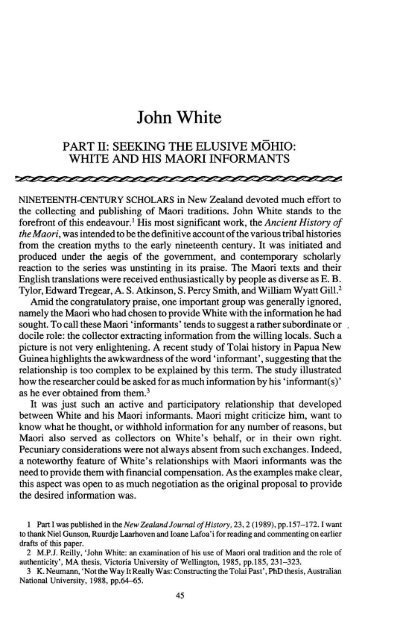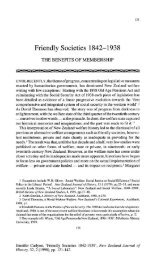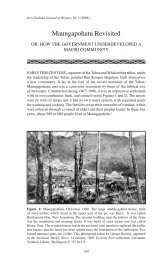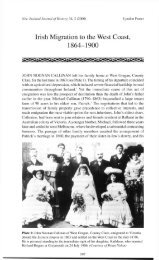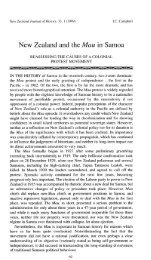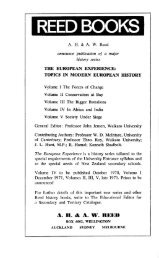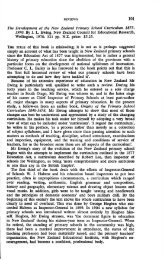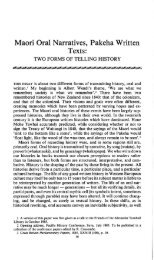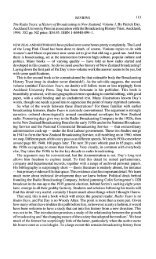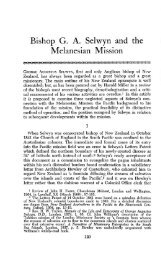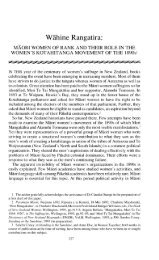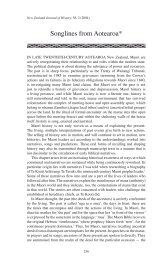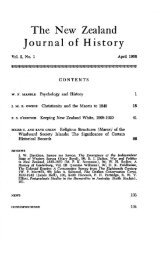John White - New Zealand Journal of History
John White - New Zealand Journal of History
John White - New Zealand Journal of History
You also want an ePaper? Increase the reach of your titles
YUMPU automatically turns print PDFs into web optimized ePapers that Google loves.
<strong>John</strong> <strong>White</strong><br />
PART II: SEEKING THE ELUSIVE MOHIO:<br />
WHITE AND HIS MAORI INFORMANTS<br />
NINETEENTH-CENTURY SCHOLARS in <strong>New</strong> <strong>Zealand</strong> devoted much effort to<br />
the collecting and publishing <strong>of</strong> Maori traditions. <strong>John</strong> <strong>White</strong> stands to the<br />
forefront <strong>of</strong> this endeavour. 1 His most significant work, the Ancient <strong>History</strong> <strong>of</strong><br />
the Maori, was intended to be the definitive account <strong>of</strong> the various tribal histories<br />
from the creation myths to the early nineteenth century. It was initiated and<br />
produced under the aegis <strong>of</strong> the government, and contemporary scholarly<br />
reaction to the series was unstinting in its praise. The Maori texts and their<br />
English translations were received enthusiastically by people as diverse as E. B.<br />
Tylor, Edward Tregear, A. S. Atkinson, S. Percy Smith, and William Wyatt Gill. 2<br />
Amid the congratulatory praise, one important group was generally ignored,<br />
namely the Maori who had chosen to provide <strong>White</strong> with the information he had<br />
sought. To call these Maori 'informants' tends to suggest a rather subordinate or<br />
docile role: the collector extracting information from the willing locals. Such a<br />
picture is not very enlightening. A recent study <strong>of</strong> Tolai history in Papua <strong>New</strong><br />
Guinea highlights the awkwardness <strong>of</strong> the word' informant', suggesting that the<br />
relationship is too complex to be explained by this term. The study illustrated<br />
how the researcher could be asked for as much information by his 'informant(s)'<br />
as he ever obtained from them. 3<br />
It was just such an active and participatory relationship that developed<br />
between <strong>White</strong> and his Maori informants. Maori might criticize him, want to<br />
know what he thought, or withhold information for any number <strong>of</strong> reasons, but<br />
Maori also served as collectors on <strong>White</strong>'s behalf, or in their own right.<br />
Pecuniary considerations were not always absent from such exchanges. Indeed,<br />
a noteworthy feature <strong>of</strong> <strong>White</strong>'s relationships with Maori informants was the<br />
need to provide them with financial compensation. As the examples make clear,<br />
this aspect was open to as much negotiation as the original proposal to provide<br />
the desired information was.<br />
1 Part I was published in the <strong>New</strong> <strong>Zealand</strong> <strong>Journal</strong> <strong>of</strong> <strong>History</strong>, 23,2 (1989), pp. 157-172.1 want<br />
to thank Niel Gunson, Ruurdje Laarhoven and Ioane Lafoa'i for reading and commenting on earlier<br />
drafts <strong>of</strong> this paper.<br />
2 M.P.J. Reilly, '<strong>John</strong> <strong>White</strong>: an examination <strong>of</strong> his use <strong>of</strong> Maori oral tradition and the role <strong>of</strong><br />
authenticity', MA thesis, Victoria University <strong>of</strong> Wellington, 1985, pp.185, 231-323.<br />
3 K. Neumann, 'Not the Way It Really Was: Constructing the Tolai Past', PhD thesis, Australian<br />
National University, 1988, pp.64-65.<br />
45
46 MICHAEL RE ILLY<br />
The story <strong>of</strong> <strong>White</strong>'s relationships with his informants is drawn either from<br />
Maori manuscript letters written to or from <strong>White</strong>, or from a journal kept by<br />
<strong>White</strong> as a young man in the Hokianga. This early journal chronicled his day-today<br />
dealings with Maori in the locality. Many <strong>of</strong> them are unidentified by name<br />
and they simply appear and disappear from the diary.<br />
One Maori who was clearly identified in the journal was Te Aho <strong>of</strong> the<br />
Mahurehure hapu at Waima. He seems to have been aged around ten or 12 in<br />
1846 or 1847; he is described as the son <strong>of</strong> a tohunga and a relation <strong>of</strong> Hone Heke.<br />
<strong>White</strong> considered him 'the only good friend I have'. The close and easy nature<br />
<strong>of</strong> their relationship is suggested by the way Te Aho was able to correct <strong>White</strong>'s<br />
use <strong>of</strong> Maori 'without any resirve', and 'in very strong language'. <strong>White</strong> added,<br />
'as he is good tempered and rather witty I put up with him'. 4 The two <strong>of</strong>ten<br />
worked together, Te Aho sometimes staying at <strong>White</strong>'s home. He was recorded<br />
as providing a range <strong>of</strong> material including traditional stories, recent historical<br />
incidents, and information on topics such as the signs <strong>of</strong> death. 5<br />
The most common technique <strong>White</strong> employed to obtain information from<br />
Maori was to tell them what he called 'tales'. These were used to encourage a<br />
response from a likely informant. The 'tales' were drawn from <strong>White</strong>'s reading<br />
<strong>of</strong> European literature, and could include synopses <strong>of</strong> Shakespearean plays,<br />
Josephus' account <strong>of</strong> the destruction <strong>of</strong> Jerusalem, or Sir Walter Scott's '7 dy<br />
<strong>of</strong> the Lake'. 6 Te Aho was not fooled about the reasons for <strong>White</strong> telling nim<br />
stories: 'told the Aho the tale <strong>of</strong> the Bear and the boy. he said I only told him it<br />
to get him to tell me more <strong>of</strong> his tales, "but" said he "you must not think but I know<br />
how you act you tell one to get 2. it may do with others but I am not to be done<br />
so," the little scamp, he has not guessed very far wrong' , 7 He was well aware that<br />
<strong>White</strong> also intended using such information for his own literary compositions.<br />
On one occasion he apparently told <strong>White</strong> he had a long tale to tell him but would<br />
not give it at that point, '"for", said he "I think you are writing tales <strong>of</strong> your own<br />
composition, besides writing all you hear from every person, and after awhile<br />
you will tell people the tales as true" he is a sharp little fellow'. 8<br />
One day Te AJio's father, identified only as a 'priest', became suspicious <strong>of</strong><br />
<strong>White</strong>'s reported knowledge and sought to interrogate him about it. Soon after<br />
Te Aho had told <strong>White</strong> a 'tale', the priest came into the house and in <strong>White</strong>'s<br />
words, 'began to question me as to the extent <strong>of</strong> my learning in bewitching'.<br />
<strong>White</strong> assured him he knew such things, 'also many <strong>of</strong> the English and <strong>of</strong> other<br />
nations'. Te Aho's father was not impressed by such reassurances. He wanted to<br />
know the name <strong>of</strong> the tohunga 'who divulged to me the most sacred <strong>of</strong> all<br />
knowledge'. <strong>White</strong> said he had sworn to keep it a secret and to only divulge it to<br />
'my own countrymen in print', to which Te Aho's father simply reiterated his<br />
belief that <strong>White</strong> knew nothing. Nevertheless, to ascertain whether this was so,<br />
4 <strong>John</strong> <strong>White</strong>, 'Private <strong>Journal</strong>' (PJ), 1846-50, 17 June 1847, Alexander Tumbull Library<br />
(ATL), Wellington.<br />
5 PJ, 15 May, 12, 26 December 1847.<br />
6 e.g. PJ, 10 February 1848, 27 October, 26 December 1846.<br />
7 PJ, 13 December 1847.<br />
8 PJ, 8 December 1847.
JOHN WHITE: SEEKING THE ELUSIVE MOHIO 47<br />
Te Aho's father wanted him to answer a few questions: first, the name <strong>of</strong> the<br />
wood used in the mākutu ceremony; second, whether 'the priest' ate anything<br />
during the ceremony, and third, 'how soon the person was supposed to live after<br />
he is bewitched'.<br />
<strong>White</strong> claimed to have answered these questions satisfactorily and that Te<br />
Aho's father 'talked to me as he would to apriest <strong>of</strong> his own country'. 9 Elsewhere<br />
<strong>White</strong> stated that Te Aho's father had interrogated him in such a manner because<br />
the latter himself did not know the ceremony and wished to learn <strong>of</strong> it. 10 After the<br />
intensive questioning, <strong>White</strong> and Te Aho's father talked on various religious<br />
practices at the battle <strong>of</strong> Ohaeawai including the rite used to ensure victory and<br />
a method used to kill a rat. <strong>White</strong> noted, 'he answered me any question which I<br />
liked to ask him, as he considered me as one <strong>of</strong> themselves that is a priest'. 11<br />
The tohunga who had given <strong>White</strong> the knowledge which sparked the above<br />
investigation was identified as Te Takurua. He also provided much else,<br />
including 'the sacred purposes' <strong>of</strong> certain shrubs, the omens <strong>of</strong> sneezing, and '2<br />
ceremonies <strong>of</strong> Priesthood'. 12 Upon <strong>White</strong> writing down the last item, Te Takurua<br />
was recorded as asking 'what good would such things do me [i.e. <strong>White</strong>], I said<br />
I perhaps should Print them for the whole world to look at, "and what good would<br />
they receive from them," he asked I said "no good perhaps amusement only, yes<br />
he said you English people are the most inquisative on the face <strong>of</strong> the earth not<br />
even our mea tapu which are but folly you cannot pass by'. 13<br />
Unfortunately, whether such 'mea tapu' (sacred things) were folly or not, Te<br />
Takurua suffered dire consequences for giving in to <strong>White</strong>'s importuning. He<br />
was accosted on returning home one day by his grandfather who accused him <strong>of</strong><br />
giving away the secrets <strong>of</strong> mākutu to a 'common man'. Subsequently Te<br />
Takurua's son and later Te Takurua himself died. Both deaths were ascribed to<br />
his giving information to <strong>White</strong>. 14 <strong>White</strong> appears not to have betrayed any signs<br />
<strong>of</strong> remorse, perhaps believing that a Maori who had apparently fallen a victim<br />
to non-Christian beliefs was not fit to be mourned over. <strong>White</strong> admitted he<br />
obtained the secrets only after <strong>of</strong>fering Te Takurua a 'payment', 15 or what he<br />
called more truthfully elsewhere, 'bribes'. 16 Ironically, when <strong>White</strong> became<br />
severely ill in 1848 and was not expected to live, he reported that a chief had<br />
suggested taking him to 'the Native Witch for the witch to Karakiatia him',<br />
adding, 'he thinks I am makutuid, bewitched'. 17<br />
Living in the Hokianga district for so long <strong>White</strong> met many well-known local<br />
Maori. Whenever the moment presented itself he sought to engage them in<br />
conversation. These talks <strong>of</strong>ten took the form <strong>of</strong> a wide-ranging, even vigorous,<br />
9 PJ, 15 March 1847.<br />
10 PJ, 18 March 1847.<br />
11 PJ, 15 March 1847.<br />
12 PJ, 14, 19 June, 1 July 1847.<br />
13 PJ, 1 July 1847.<br />
14 PJ, 19 June 1847, 17 September 1849.<br />
15 PJ, 19 June 1847.<br />
16 <strong>White</strong> to Thomas Moore (the poet), 7 June 1848, <strong>John</strong> <strong>White</strong> Papers, MS 75 (JWMS), A77a,<br />
A141, ATL.<br />
17 PJ, 6 December 1848.
48 MICHAEL RE ILLY<br />
series <strong>of</strong> questions, not all <strong>of</strong> them necessarily being asked by <strong>White</strong>. In 1847 he<br />
accompanied the missionary <strong>John</strong> Hobbs up the Waima river and witnessed a<br />
hahunga (ceremony <strong>of</strong> disinterment for reburial). He met the Ngati Rangi chief<br />
Penetaui, whom he described as the person who had burnt a soldier at the battle<br />
<strong>of</strong> Ohaeawai. <strong>White</strong> noted that 'he is young very good looking, tall black eyes,<br />
and black curly hair, very chatty'. The latter quality usually signified a good<br />
informant to <strong>White</strong>. Penetaui asked <strong>White</strong> to tell him all the divisions <strong>of</strong> time,<br />
which he did; 'in return I asked him to tell me the meaning <strong>of</strong> a song which is sung<br />
at all hahunga'. Apparently he could not, nor could 'an old chief sitting nearby<br />
to whom Penetaui had then directed the same question. Penetaui suggested that<br />
only the composer could give an answer. Then extending his initiative, he asked<br />
<strong>White</strong> what he thought the song meant.<strong>White</strong> replied, but 'it being such a<br />
laughable meaning that it made all the whole tribe laugh'. After Penetaui 'was<br />
done laughing' he is reported to have said that <strong>White</strong> knew more than the 'old<br />
Priests'.<br />
The journal then described the context in which the question and counterquestion<br />
session occurred. There seem to have been certain tensions amongst<br />
those attending the ceremony. Penetaui and his tribe were sitting in a body, 'in<br />
the midst <strong>of</strong> those who were once his enemies'. This factor apparently prevented<br />
others participating actively in the session. They simply sat and listened 'to what<br />
we were talking about not daring to speak'. The unstated tensions may,<br />
presumably, have also affected the responses <strong>of</strong> Penetaui and the 'old chief.<br />
Perhaps with a certain amount <strong>of</strong> relief on their part the party then proceeded to<br />
discuss whether one could see a cannon ball in flight. 18<br />
One prominent Maori, Aperahama Taonui <strong>of</strong> Te Popoto hapu, is mentioned<br />
a number <strong>of</strong> times during <strong>White</strong>'s period in the Hokianga. He was also to figure<br />
throughout <strong>White</strong>'s life as a source <strong>of</strong> knowledge. He provided a 'history <strong>of</strong> the<br />
old times', which included 'the line <strong>of</strong> the Ngapuhi family' from their discovery<br />
<strong>of</strong> <strong>New</strong> <strong>Zealand</strong>. 19 Like Te Takurua, Taonui had problems with restricted<br />
information. According to <strong>White</strong>, Taonui had wanted to record the Hokianga<br />
whakapapa (genealogies), but was dissuaded for a long time by 'the old chiefs',<br />
who claimed Taonui would 'put the paper in your [Taonui's] box amongst<br />
tobacco, [and] other things, and sacred things should not be thus treated'. 20<br />
The journal preserves an excellent example <strong>of</strong> the type <strong>of</strong> question, answer,<br />
and counter-question <strong>White</strong> and his informant(s) <strong>of</strong>ten engaged in. One evening<br />
Taonui came to visit, and <strong>White</strong> promptly asked him about the moa. Taonui then<br />
proceeded to tell how a chief called Ngaro had, a few years before, found 'a lot<br />
<strong>of</strong> large bones up Waihou'. Ngaro reportedly threw them away, but Taonui had<br />
obtained or seen the skull. He compared it to a dog's and supposed it had eaten<br />
other animals. After referring to the use <strong>of</strong> such bones for the manufacture <strong>of</strong> fish<br />
hooks, he asked <strong>White</strong> how he accounted for such an animal (presumably the<br />
moa) being extinct. Drawing on his own reading, <strong>White</strong> explained that it may<br />
18 PJ, 23 February 1847.<br />
19 PJ, 16 June 1849.<br />
20 PJ, 30 December 1848.
JOHN WHITE: SEEKING THE ELUSIVE MOHIO 49<br />
have become extinct because the climate 'is getting colder' and 'the vegetabls<br />
on which they lived would not now grow'. Taonui accepted this view but then<br />
wondered whether 'the flood' (biblical deluge?) may not have destroyed the moa<br />
instead. <strong>White</strong> then pointed out that the soil in which the bones were found would<br />
not have preserved them for so long a timespan as 'the flood' would require.<br />
He then asked Taonui how old he thought <strong>New</strong> <strong>Zealand</strong> was. According to the<br />
journal, Taonui replied that' we. . . natives may have occupied it for 800 years'.<br />
<strong>White</strong>, probably pleased to hear this, confirmed that 'our geologists say it is a<br />
young country'. Apparently as a means <strong>of</strong> proving the time-depth <strong>of</strong> Maori<br />
settlement, Taonui promised to give ' "the name <strong>of</strong> 37 men, who were each <strong>of</strong><br />
them the first born <strong>of</strong> their families" '. 21 As this example demonstrates, the<br />
collector/informant situation had become an exchange <strong>of</strong> knowledge between<br />
two interested parties.<br />
During the 1850s Taonui maintained a correspondence with <strong>White</strong> concerning<br />
his requests for information. By this time <strong>White</strong> lived in Auckland, working<br />
first for Sir George Grey, and then from 1852 in the civil service. The most<br />
striking feature <strong>of</strong> Taonui's four extant letters was the series <strong>of</strong> excuses he<br />
pr<strong>of</strong>fered for not recording the information <strong>White</strong> sought. Some <strong>of</strong> these<br />
objections were very real. In September 1856 he claimed the explanations<br />
(tikanga) <strong>of</strong> waiata (songs), whakataukl(proverbs) and other material <strong>White</strong> had<br />
requested could not be completed for several years. 22 A month later lengthy<br />
illness had delayed his finishing a large manuscript book. 23 In the same letter he<br />
seemed reluctant to continue writing at all owing, he said, to the work's enormity<br />
and difficulty ('he mahi nui whakaharahara'). He wanted <strong>White</strong> to decide<br />
whether it ought to continue. He also specifically declined to collect information<br />
on mākutu (witchcraft) from those tohunga knowledgeable about it. He claimed<br />
it would be both disrespectful and show ignorance on his part ('e kore e tika te<br />
ui he mea kino te ui mate kuare kaui ai').<br />
He also voiced concern over the question <strong>of</strong> publishing his manuscript<br />
writings. If these were finished, he wrote, he wanted to meet <strong>White</strong> to discuss the<br />
benefits <strong>of</strong> publishing and selling them to the Pakeha public. He did not want any<br />
Maori to get hold <strong>of</strong> the work as it had many new words in it and this could<br />
generate great ill-feeling and criticism. He had shown the work to another Maori,<br />
who agreed with his views, suggesting the material would turn Maori who read<br />
it away from God. 24<br />
Other objections raised were more trivial. In 1850 Taonui reported that he had<br />
not been able to finish their manuscript book because he had no ink and was busy<br />
sawing planks. 25 The following year he had no paper and could not write anyway<br />
21 ibid.<br />
22 Taonui to <strong>White</strong>, 8 Hepetema (September) 1856, JWMS, A8a, ATL. The English<br />
translations <strong>of</strong> Taonui's letters were originally made by the translation service, Department <strong>of</strong><br />
Internal Affairs. I have made some minor corrections. All other translations in this paper are my<br />
own. Some were very kindly checked and corrected by the late Ruka Broughton.<br />
23 Taonui to <strong>White</strong>, 26 Oketopa (October) 1856, JWMS, A8a, ATL.<br />
24 ibid.<br />
25 Taonui to <strong>White</strong>, 13 Hanueri (January) 1850, JWMS, A8a, ATL.
50 MICHAEL RE ILLY<br />
until his house was finished, though he promised to write more material at night<br />
once it was completed. 26 In September 1856 he again had no ink to complete their<br />
manuscripts. <strong>White</strong> apparently sought to remedy the lack <strong>of</strong> writing material by<br />
sending some books by ship, and a further supply comprising a manuscript book,<br />
ink and pens a short time later. 27<br />
From the 1870s, and increasingly with his appointment in 1879 to prepare the<br />
Ancient <strong>History</strong> <strong>of</strong> the Maori, <strong>White</strong> initiated a large number <strong>of</strong> requests,<br />
typically instructing his potential informant to 'write as full as you can <strong>of</strong> all the<br />
<strong>History</strong> <strong>of</strong> the Maori, give everything you can no matter how trivial'. 28 If <strong>White</strong><br />
expected armfuls <strong>of</strong> manuscript books to be returned brimming with Maori<br />
history he was soon disappointed. In October 1879 Eru Tahitangata <strong>of</strong> Otaki<br />
informed him that a committee (presumably <strong>of</strong> local Maori elders) would not<br />
agree to sending him any whakapapa or karakia (prayers). Needless to say <strong>White</strong><br />
reacted sharply, commenting on the back <strong>of</strong> Tahitangata's letter: 'if you do not<br />
like to give your Histy, you will be the only tribe not knowfn] to future ages'.<br />
<strong>White</strong> asked for his manuscript volume back so that he could give it to someone<br />
else. 29<br />
More bad news was to follow. In April 1880 a despondent Henare Paraone<br />
from Napier, first sent a book in 1875, wrote that it had been taken away and<br />
hidden by his people while he was collecting more material in Waimarama. He<br />
thought they had hidden the work when they saw what was written inside. 30<br />
<strong>White</strong> also learnt that the book sent in 1876 to Tamati Hapimana <strong>of</strong> Ohiwa in the<br />
Bay <strong>of</strong> Plenty had been accidentally burnt in a house fire. <strong>White</strong> soon sent a<br />
replacement, only to learn from Hapimana that he could not completely fill this<br />
new volume since there were no longer any tohunga. 31 On a more optimistic note,<br />
however, Kawana Hunia (Te Hakeke?) <strong>of</strong> Parewanui (Bulls) in the Rangitikei<br />
confirmed that he had organized six chiefs from Ngati Kahungunu <strong>of</strong> Wairarapa<br />
to write for <strong>White</strong>. The chiefs were Ngario Takatakaputea, Ngatuere, Heremaia<br />
Te Whatu, Tamai Kohia, Wi Waaka and Tikawenga. 32<br />
Maori writers encountered a variety <strong>of</strong> problems themselves, or shared a<br />
reluctance to provide the required information. The Reverend Wiremu Patene<br />
from the Waikato asked <strong>White</strong> to indicate which particular whakapapa and<br />
ancestors he needed information about. 33 Hohaoia Tarakawa <strong>of</strong> Pukerimu seems<br />
26 Taonui to <strong>White</strong>, 19 Aperira (April) 1851, JWMS, A8a, ATL.<br />
27 Taonui to <strong>White</strong>, 8 Hepetema 1856, 26 Oketopa 1856, JWMS, A8a, ATL.<br />
28 Ledger book, JWMS, Alll, ATL. The ledger contained an alphabetically arranged list <strong>of</strong><br />
people to whom requests were sent to write on Maori history between about 1879 and 1885.<br />
29 Tahitangata to <strong>White</strong>, 13 October 1879, NZMS 714, Vol. IV, Auckland Public Library (AP);<br />
<strong>White</strong>'s comment, written on the back <strong>of</strong> the letter, 12 November 1879.<br />
30 Paraone to <strong>White</strong>, 4 Aperira 1880, JWMS, Alia, ATL. Various place-names appear in the<br />
correspondence with Paraone, including Matahiwi and Pa Kowhai, Napier.<br />
31 Ledger book, JWMS, Alll, ATL; Hapimana to <strong>White</strong>, 26 July 1880, NZMS 714, Vol IV, AP.<br />
The place-name in the last letter is Te Awahou. Hapimana's name is written in one place in the<br />
ledger book as Tamati Hapimana Karinga, in another simply as Tamati Hapimana.<br />
32 Ledger book, JWMS, Alll, ATL. A letter from Hunia is signed Kawana Hunia Te Hakeke,<br />
but it is not clear whether Te Hakeke is a personal or place name.<br />
33 Patene to <strong>White</strong>, 18 Maehe (March) 1881, JWMS, A65, ATL. Patene lived either at<br />
Karakiariki, Karokariki, or Karakariki (depending on the spelling).
JOHN WHITE: SEEKING THE ELUSIVE MOHIO 51<br />
to have sought some form <strong>of</strong> contract or agreement before he would write the<br />
traditions <strong>White</strong> wanted. 34 Ihaia Te Whakamaira Te Hupu <strong>of</strong> Masterton<br />
(Mahitaone) had been unable to continue work on a manuscript due to the local<br />
opposition instigated apparently by 'poropiti maori' (Maori prophets). 35 Tahitangata,<br />
who had already refused to give material in 1879, again made it clear<br />
that Ngati Raukawa chiefs would not agree to giving their ancestors away to<br />
<strong>White</strong>. 36 Henare Hau <strong>of</strong> Waimate, faced with a lack <strong>of</strong> kaumātua, could not<br />
provide any traditions about the ancient times. 37 Piripi Maki (or Ngaki?) from<br />
Onepu, Te Aute, had a similar crisis when the original informant, whose<br />
knowledge he was to record, died. He promised to find an alternative person,<br />
though his work had so far prevented him finding one. 38 A more hopeful note was<br />
struck by Timi Waata Rimini <strong>of</strong> Maketu who, despite some delay in getting<br />
material written, was now able to assure <strong>White</strong> it was going well. 39 Te Winitana<br />
Tupotahi <strong>of</strong> Kihikihi in the Waikato had not recorded anything at all but he had<br />
found people knowledgeable in the old traditions who could. 40<br />
During 1886 several letters were exchanged between <strong>White</strong> and the Rangitane<br />
chief Hoani Meihana Te Rangiotu. These vividly present the sort <strong>of</strong> trials<br />
encountered by Maori informants attempting to collect or record traditional<br />
material. Writing in March, Te Rangiotu confirmed that he had put all he knew<br />
in a manuscript which a mokopuna (grandchild) was supposed to send to <strong>White</strong>.<br />
However, he (or she) had not done so. Later, while in Wellington, Te Rangiotu<br />
had tried to see <strong>White</strong> about it, but had not been able to. He promised to rewrite<br />
his material and send it himself. 41 However, only one month later the undertaking<br />
was delayed again by his mokopuna, who it seems had hidden the manuscript.<br />
Te Rangiotu had also been held up by trouble encountered at hui, possibly<br />
concerning this work. Nonetheless, he hoped to make another request (presumably<br />
for traditions) at a Wairarapa hui. 42 After receiving this letter <strong>White</strong> must<br />
have written back wanting information on certain topics. Te Rangiotu, however,<br />
had had problems with the Whanganui Land Court and could not respond to the<br />
letter until he arrived home in late September. He thought the lengthy delay<br />
meant that any material would now arrive too late for inclusion in <strong>White</strong>'s<br />
publications. Nor did he think he could complete everything <strong>White</strong> had asked for.<br />
<strong>White</strong>, however, encouraged him to write all the history he could. 43<br />
Later the following year <strong>White</strong> sought out another informant, Te Whatahoro<br />
Jury, then <strong>of</strong> Grey town. Te Whatahoro later contributed information to S. Percy<br />
34 Tarakawa to <strong>White</strong>, 22 Hune (June) 1880, NZMSS 31, AP.<br />
35 Te Hupu to <strong>White</strong>, 21 Maehe 1881, JWMS, A1 la, ATL. Te Hupu was variously described as<br />
living at Manaia, Mahitaone, or, Manaia, Marotutu, Wairarapa.<br />
36 Tahitangatato <strong>White</strong>, 1 Pepueri (February) 1883, A.F. McDonnell Papers, MSS 151/3, ATL.<br />
37 Hau to <strong>White</strong>, 31 Hanuere 1883, JWMS, A65, ATL.<br />
38 Maki to <strong>White</strong>, 17 Aperira 1883, NZMS 714, Vol. IV, AP.<br />
39 Rimini to <strong>White</strong>, 5 Aperira 1881, JWMS, A65, ATL.<br />
40 Tupotahi to <strong>White</strong>, 6 Pepuere 1883, MSS 151/14, ATL.<br />
41 Te Rangiotu to <strong>White</strong>, 11 Maehe 1886, JWMS, A65, ATL.<br />
42 Te Rangiotu to <strong>White</strong>, 12 Aperira 1886, JWMS, B36, ATL.<br />
43 Te Rangiotu to <strong>White</strong>, 28 Hepetema 1886, MSS 151/14, ATL; <strong>White</strong>'s note on letter dated 1<br />
October 1886. Te Rangiotu lived at Oroua Piriti near Palmerston North.
52 MICHAEL RE ILLY<br />
Smith. On 24 November 1887, Jury acknowledged a request to send manuscript<br />
books containing traditions <strong>of</strong> the past. Amongst the topics he intended providing<br />
<strong>White</strong> with were:<br />
nga Pakanga, nga whakapapa tipuna me te korero o te Haerenga mai o Tamatea i tera motu<br />
ara i Hawaiki, me te korero tino tika o tenei tipuna o Maui Tikitiki a Taranga kaore i penei<br />
tenei i te pukapuka a Kawana Kerei nei me te korero o te Iwi i rokohina mai i runga i tenei<br />
motu, ara te Patupaiarehe, muri mai ko te whanau a Roka Maomao muri mai ko te aitanga<br />
a Toi muri mai ko Ngai Tara muri mai ko te aitanga a Whatonga me te aitanga a Hoturoa<br />
me te aitanga a Tamatekapua me te aitanga a Paoa me te aitanga a Rauruati [?] me te<br />
aitanga a Ngatoroirangi, muri mai ko Tamatea ma tenei....<br />
the battles, the ancestors' genealogies, and the migration tradition <strong>of</strong> Tamatea from that<br />
island i.e. Hawaiki, and the most correct version <strong>of</strong> the tradition <strong>of</strong> this ancestor, Maui<br />
Tikitiki a Taranga which is not like that in Governor Grey and the tradition <strong>of</strong> the people<br />
found on this island, i.e. the Patupaiarehe, after that the family a Roka Maomao after that<br />
the descendants <strong>of</strong> Toi after that Ngai Tara after that the descendants <strong>of</strong> Whatonga and<br />
the descendants <strong>of</strong> Hoturoa and the descendants <strong>of</strong> Tamatekapua and the descendants <strong>of</strong><br />
Paoa and the descendants <strong>of</strong> Rauruati and the descendants <strong>of</strong> Ngatoroirangi, after that<br />
Tamatea and the others. . . .<br />
Since these traditions were quite lengthy and were scattered throughout his<br />
manuscripts, he proposed to compress the material for <strong>White</strong> ('Engari era e roa<br />
au e whakawhaiti ana i au a korero kei te takoto mararara noa atu i roto i nga<br />
Pukapuka'). According to Te Whatahoro, he had compressed this knowledge<br />
while the learned tohunga were still alive ('I whakawhaititia nei e au, I te wa e<br />
ora ana nga pukenga mahara penapena korero o namata'). He may also already<br />
have provided <strong>White</strong> with some manuscript material, as he asked for the return<br />
<strong>of</strong> one <strong>of</strong> his books <strong>of</strong> whakapapa. 44<br />
In January <strong>of</strong> the following year, Jury acknowledged receipt <strong>of</strong> some books<br />
from <strong>White</strong> and the accompanying request to fill them quickly with information<br />
on ancestors so they could be printed. Obviously <strong>White</strong> hoped to incorporate the<br />
material fairly prompdy into the Ancient <strong>History</strong>. Te Whatahoro wrote that he<br />
had already begun explaining the ancestors from Rangi and Papa to the present<br />
day ('Kei te mahia e au kia pai kia marama nga putake me nga wehewehenga mai<br />
i o ratau putake timata ia Rangi raua ko Papa tae mai nei kia matau. . .'). 45<br />
Despite such optimism, it seems that even co-operative informants such as Te<br />
Whatahoro took some time to complete writing manuscripts. More than a year<br />
after Te Whatahoro's last letter <strong>White</strong> admitted he still had not received any<br />
manuscripts from him. 46 The previous year <strong>White</strong> had also requested Te<br />
Whatahoro to ask Te Rangiotu for any history the latter may have written; 47 this<br />
44 Te Whatahoro to <strong>White</strong>, 25 Noema (November) 1887, JWMS, A65, ATL. Te Whatahoro<br />
wrote his letters either from Wellington or Greytown, Te Wharepakihi.<br />
45 Te Whatahoro to <strong>White</strong>, 20 Hanueri 1880, JWMS, A65, ATL.<br />
46 Note, 9 March 1889, JWMS, A65, ATL. This marginal note is attached to a letter from E.<br />
Manga.<br />
47 Note, 9 March 1888, JWMS, A65, ATL. The note is attached to Te Whatahoro's letter <strong>of</strong> 20<br />
Hanueri 1888.
JOHN WHITE: SEEKING THE ELUSIVE MOHIO 53<br />
was some two years after Te Rangiotu had promised <strong>White</strong> to record traditions.<br />
The problems did not end here, since some Maori naturally disputed the<br />
information others provided. In 1889 Erueti Turei Manga <strong>of</strong> Papawai, who<br />
thought Te Whatahoro had by then supplied material, queried the latter's Ngati<br />
Tahu genealogies. Manga asked <strong>White</strong> to stop printing them as he was carefully<br />
writing out the correct versions. These had not been provided earlier because<br />
<strong>White</strong> had collected the manuscript books before Manga and other Maori were<br />
ready to record their information. 48 <strong>White</strong> promised to insert their whakapapa<br />
into the Ancient <strong>History</strong>.® In another incident, Hopa Paura Te Waitutu and Hoani<br />
Rapatini <strong>of</strong> Taumutu in Canterbury jointly queried a Nga Rauru account in Te<br />
Korimako, presumably inserted by <strong>White</strong>, who translated for the magazine. They<br />
pleaded for him not to insert this particular account in his 'Takitumu' section <strong>of</strong><br />
the Ancient <strong>History</strong>. 50 They had also found what they considered to be a further<br />
false Nga Rauru tradition in the Ancient <strong>History</strong>. They sought to prove this<br />
assertion by showing their own Ngai Tahu claims to the material. In a postscript<br />
Te Waitutu provided information on an ancestor who he claimed was left out <strong>of</strong><br />
a genealogy in the history volume. 51<br />
A few <strong>of</strong> <strong>White</strong>'s contributors were even apologetic about the traditions they<br />
provided. One unidentified writer explained them away as being the stories from<br />
the man-eating people in the past ('no mua aua korero na te iwi kai tangata'). 52<br />
Te Rangiotu was reluctant even to write about them. He had now realized, he<br />
wrote, that the deeds <strong>of</strong> the ancestors and the parents were very bad ('He mahi<br />
kino rawa nga mahi a nga Tupuna, a nga matua'). He sought to reassure <strong>White</strong><br />
that the Maori had very definitely changed his views. 53<br />
Maori informants, in particular those approached to contribute material for<br />
the Ancient <strong>History</strong>, early began to push for financial rewards. Some sought to<br />
bargain. In 1881 Te Rei Paehua <strong>of</strong> Te Waiotu in the Waikato seems to have<br />
initiated these pecuniary pressures, as <strong>White</strong> noted in a copy <strong>of</strong> his reply to<br />
Paehua: 'I will pay for history according to value and quantity'. 54 About a week<br />
and a half later Paehua telegrammed, enquiring after the value <strong>of</strong> his work;<br />
presumably, he wanted <strong>White</strong> to give a specific figure. He also asked him to<br />
forward payment. 55 Until 1883 the going rate was calculated at £5 for any<br />
manuscript book returned full, or nearly full. A few informants were <strong>of</strong>fered £5<br />
48 Manga to <strong>White</strong>, 5 Maehe 1889, JWMS, A65, ATL.<br />
49 Note, 9 March 1889, JWMS, A65, ATL.<br />
50 This was the spelling <strong>of</strong> Takitimu used by <strong>White</strong> in his history volumes. The use <strong>of</strong> the<br />
Rarotongan Maori version <strong>of</strong> the canoe's name suggests he was influenced by Cook Island<br />
ethnographies, the most likely being W.W. Gill's Historical Sketches <strong>of</strong> Savage Life in Polynesia,<br />
published in 1880 by the <strong>New</strong> <strong>Zealand</strong> Government Printer. <strong>White</strong>'s use <strong>of</strong> the Rarotongan form<br />
was originally pointed out to me by Agnes Sullivan.<br />
51 Te Waitutu and Rapatini to <strong>White</strong>, 24 Aperira 1888, JWMS, B24, ATL.<br />
52 JWMS, B24, ATL. This document, entitled 'He whitu enei no Te Rangi', was originally cast<br />
in the form <strong>of</strong> a letter to <strong>White</strong>.<br />
53 JWMS, B25, ATL. A collection <strong>of</strong> whakapapa entitled 'Descendants <strong>of</strong> Rangi and Papa';<br />
some <strong>of</strong> the material at least dates from October 1859.<br />
54 Ledger book, JWMS, A111, ATL.<br />
55 Paehua to <strong>White</strong>, 18 March 1881, JWMS, A65, ATL.
54 MICHAEL RE ILLY<br />
simply if they returned any manuscript book in their possession, apparently with<br />
no regard to the amount or quality <strong>of</strong> the information they contained. <strong>New</strong> <strong>of</strong>fers<br />
despatched after January 1883, however, changed the bargain from £5 for a<br />
manuscript book to 6d. for every page <strong>White</strong> copied. 56<br />
Not surprisingly some criticisms <strong>of</strong> these payments, or the lack <strong>of</strong> them,<br />
emerged. Maki suggested he could have found someone to record traditions<br />
faster if the government had recompensed him for the search. He thought <strong>White</strong><br />
ought to have assisted people financially to do this. 57 Tupotahi seemed unsure his<br />
informants would be happy with the payment <strong>White</strong> <strong>of</strong>fered. 58 A Pakeha<br />
collector, T. G. Hammond, thought <strong>White</strong> would have to pay Hone Mohi Tawhai<br />
<strong>of</strong> Waima in the Hokianga a great deal as he intended his 'mohio' (knowledge)<br />
for another collector. 59 On the other hand Hoani Tainui <strong>of</strong> Arahura near Hokitika<br />
found <strong>White</strong> slow to pay and had to write him a gentle reminder. 60<br />
During 1885 a fascinating series <strong>of</strong> letters was exchanged between <strong>White</strong>,<br />
Marakai Kune and Hamiora Pio about just such financial arrangements. <strong>White</strong><br />
had sent Kune books to record traditions from Pio, a prominent Ngati Awa<br />
tohunga. 61 Pio was also to act as one <strong>of</strong> Elsdon Best's informants. 62 He proved<br />
quite willing to record his knowledge about <strong>New</strong> <strong>Zealand</strong>, its people and their<br />
whakatauki", provided <strong>White</strong> paid him £20. If <strong>White</strong> agreed, he was to send a<br />
portion <strong>of</strong> the money as well as another book to Te Teko. 63 In late July Kune<br />
informed <strong>White</strong> that the recording was under way. Adverting to the financial<br />
arrangements, he suggested that <strong>White</strong> send the payment by steamer to Pio at<br />
Whakatane or Auckland. If he could not do this he was to contact Pio at Te<br />
Teko. 64 In August 1885 both Pio and Kune wrote informing <strong>White</strong> that they had<br />
completed their recording <strong>of</strong> traditions ('kua oti katoa nga korero, me nga<br />
tupuna, me nga wakatauki me nga karakia me nga Waka, me nga meakatoa') (the<br />
traditions, the ancestors, the proverbs, the karakia, the canoes, and all the other<br />
things have been completed). They asked him to send them the money, undertaking<br />
to forward the manuscripts once the funds had arrived. 65 <strong>White</strong> promised<br />
to pay 6d. a page in cash and to repay their postage once Pio and Kune had passed<br />
the books on to him. 66<br />
What is striking about these exchanges is the way the different parties wrote<br />
about the knowledge, or 'mohio' as one correspondent put it, <strong>of</strong> the Maori' s past.<br />
56 Ledger book, JWMS, Alll, ATL; letters franked O.H.M.S. about Maori <strong>History</strong>, c.<br />
1881-1884, JWMS, Alll, ATL.<br />
57 Maki to <strong>White</strong>, 17 Aperira 1883, NZMS 714, Vol. IV, AP.<br />
58 Tupotahi to <strong>White</strong>, 6 Pepuere 1883, MSS 151/14, ATL.<br />
59 Hammond to <strong>White</strong>, 9 December 1883, JWMS, A119b, ATL.<br />
60 Tainui to <strong>White</strong>, 20 May 1887, MS 328, Auckland Institute and Museum.<br />
61 Ledger book, JWMS, Alll, ATL.<br />
62 H.M. Mead, ed., Nga Taonga tuku iho a Ngati Awa o Te Awa-a-te-Atua, o Rangitaiki, o<br />
Whakatane: Ko nga tuhituhinga a Hamiora Tumutara Te Tihi-o-te-whenua Pio. The Heritage <strong>of</strong><br />
Ngati Awa <strong>of</strong> the three rivers—Tarawera, Rangitaiki, Whakatane: The Writings <strong>of</strong> Hamiora<br />
Tumutara Te Tihi-o-te-whenua Pio. Wellington, 1981, p.2. Maori language text.<br />
63 Pi[o] to <strong>White</strong>, 26 Hune 1885, JWMS, A65, ATL.<br />
64 Kune to <strong>White</strong>, 24 Hurae (July) 1885, JWMS, A65, ATL.<br />
65 Ko and Kune to <strong>White</strong>, 25 Akuhata (August) 1885, JWMS, A65, ATL.<br />
66 Note, 30 September 1885, JWMS, A65, ATL.
JOHN WHITE: SEEKING THE ELUSIVE MOHIO 55<br />
Throughout the many dealings outlined, knowledge seems to possess an almost<br />
independent existence. For <strong>White</strong>, it was a valued and sought after commodity<br />
that might contribute to the building up, for Europeans, <strong>of</strong> their comprehension<br />
<strong>of</strong> Maori history. For a scholar like Sir George Grey, acquiring this knowledge<br />
was a way by which he believed he could better control the Maori he was to<br />
govern. 67 <strong>White</strong> also wrote <strong>of</strong> his concern to preserve or 'embalm' Maori<br />
knowledge, and to save it from dying out. 68 It was commonly assumed (or hoped)<br />
by many Pakeha that the Maori race would soon become extinct. Their knowledge<br />
then would, in a sense, become the property <strong>of</strong> the European, able to be used<br />
(or abused) as they thought fit.<br />
The many refusals <strong>of</strong> Maori to give their knowledge, and their various<br />
attempts to enter into negotiations regarding the conditions for giving it, point to<br />
the continued value <strong>of</strong> tradition to Maori as an inheritance and as an heirloom.<br />
The concept <strong>of</strong> tradition possessing its own mauri (life force), independent <strong>of</strong> its<br />
owners, who possess it as a gift from their ancestors and who may, in turn, pass<br />
it on to their descendants, 69 must surely have partly informed the responses<br />
<strong>White</strong>'s informants gave him. The fact that he was outside the passage <strong>of</strong><br />
inheritance and a Pakeha, known to be collecting the traditions for a project<br />
sponsored by the very same governments who were seeking on other fronts to<br />
undermine Maori resources, must also have prompted, at least for some, a certain<br />
diffidence. Nor were the various pecuniary requests necessarily in conflict with<br />
the idea <strong>of</strong> the mauri <strong>of</strong> tradition. These may simply have been a recognition that<br />
money was a valued commodity for Europeans and, therefore, an appropriate<br />
form <strong>of</strong> compensation for giving an apparently equally valued item.<br />
The resemblances to the current disputes surrounding the Treaty <strong>of</strong> Waitangi<br />
inevitably remind us that the relations between <strong>White</strong> and his Maori informants<br />
are situated within a wider arena. On the one hand, there could be a fruitful<br />
sharing <strong>of</strong> learning and thought between both parties but, on the other, their<br />
relationship was part <strong>of</strong> 'the realities <strong>of</strong> power and authority', as Edward Said has<br />
observed. 70 A web <strong>of</strong> subtle connections exist between apparently disinterested<br />
scholarship and the wider political and social issues involving the ownership and<br />
control <strong>of</strong> knowledge.<br />
Research School <strong>of</strong> Pacific <strong>History</strong><br />
Australian National University<br />
Canberra<br />
MICHAEL REILLY<br />
67 Sir G. Grey, Nga Mahi a nga Tupuna, 4th ed., Wellington, 1971, pp.xiii-xiv.<br />
68 J. <strong>White</strong>, Te Rou; or, The Maori at home, London, 1874, p.v.<br />
69 T. Kruger, personal communication, 1980; J. Rangihau, 'Learning and Tapu', in M. King, ed.,<br />
Te Ao Hurihuri, Wellington, 1975, p. 12.<br />
70 The World, the Text, and the Critic, London, 1984, p.5.


